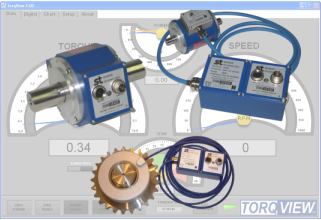 Measuring rotary torque on a test rig is one thing, but the environmental challenges of real world applications will impact on functionality and reliability.
Measuring rotary torque on a test rig is one thing, but the environmental challenges of real world applications will impact on functionality and reliability.
In marine, agricultural, renewable energy, offshore and materials handling industries, as well as more specialist sectors such as aerospace or Formula 1, torque sensors have to deal with dust, dirt, condensation, extremes of temperature, vibration, and the effects of electrical noise and interference. These can quickly impact on the reliability and accuracy of the torque data. Let’s consider torque measurement instruments built on the most widely used principles – strain gauges, phase measurement, magnetism and surface acoustic waves – and see how they compare.
A quick recap first on the different principles: The strain gauge is a sensor that is bonded directly to the shaft, connected to the signal conditioning unit using either slip rings or inductive coupling.
Phase measurement techniques use various different sensor technologies, including optical, proximity and displacement. The principle is similar for each: if sectioned or toothed discs are mounted at either end of the shaft, offset from one another, then the relative movement of the two discs is proportional to torque and can be detected.
 Magnetic measurement techniques use the principle of changes in the magnetic field of a material as it twists. The resulting changes are proportional to the applied torque, and can be measured by magnetic field sensors, enabling the torque value derived.
Magnetic measurement techniques use the principle of changes in the magnetic field of a material as it twists. The resulting changes are proportional to the applied torque, and can be measured by magnetic field sensors, enabling the torque value derived.
A relatively new technology uses surface acoustic wave (SAW) devices, where strain is applied to a shaft on which SAWs are bonded. The applied torque causes a deformation of the SAW device, which causes a change in its resonant frequency. Such devices have been pioneered by Sensor Technology in its TorqSense range. In these products, two SAWs made of ceramic piezoelectric materials containing frequency resonating combs are glued onto the shaft at 90 degrees to one another.
As the torque increases, the combs expand or contract proportionally to the applied torque. An adjacent RF pickup emits radio waves towards the SAWs, which are then reflected back. The change in frequency of the reflected waves identifies the torque. There is no need to supply power to the SAWs, so the sensor is non-contact and wireless.
So how do these different technologies stand up to demanding environmental conditions?
 Vibration
Vibration
Strain gauges: Where slip rings and brushes are used, excessive vibration can quickly cause wear, and lead to premature failure. In radio telemetry products, maintaining the correct antenna gap is critical, and excessive vibration can impact on this.
Phase measurement: Reliable operation depends on accurate alignment of the discs and sensors. If vibration causes any shift in position of the sensing elements within the transducer, the reliability of the output is compromised.
Magnetic: Relatively immune to the problem of vibration.
Surface acoustic wave: Excellent resistance to mechanical vibration.
Temperature
Strain gauges: Relatively immune to changes in temperature, although large swings can cause condensation which can impact on the electrical connections of slip rings and bushes, as well as promoting corrosion.
Phase measurement: Critical disc tooth or aperture dimensions can change with temperature, impacting on the reliability of the torque reading.
Magnetic: Permeability can vary with temperature.
Surface acoustic wave: Inherently insusceptible to temperature change, although for absolute reliability Sensor Technology integrates sensors to monitor shaft temperature for better compensation/accuracy.
Dust and dirt
Strain gauges: Brushes can be compromised by dirt, impacting on overall reliability.
Phase measurement: Operation of optical sensors will eventually be compromised by a build up of dirt, whilst any dirt or debris collecting on the discs can cause a false reading.
Magnetic: Relatively Insusceptible to dirt and dust
Surface acoustic wave: Inherently able to withstand dirt and dust.
Noise and electromagnetic interference
Strain gauges: Slip ring/brush connections can generate high levels of electrical noise, and are susceptible to electrical noise. Transformer and RF coupled strain gauges can compromised by electromagnetic interference.
Phase measurement: No susceptibility to electromagnetic interference/noise.
Magnetic: Permeability can vary with magnetism.
Surface acoustic wave: No susceptibility to electromagnetic interference/noise.

Looking at any single environmentally challenging issue, there are any number of possible torque measurement technologies that could offer a reliable solution. But in the most demanding applications, where the torque transducer would most likely have to deal with a whole raft of different ambient conditions, it becomes clear that surface acoustic wave technology offers decisive advantages.
Sensor Technology’s TorqSense transducers are widely used throughout a spectrum of the most demanding industries. Easily embedded within the system design these transducers can withstand heat, dirt and mechanical vibration, eliminate noise problems and issues of mechanical compliance. Where the environmental conditions are particularly extreme, then versions are available with the electronics housed in a physically separate enclosure which can be positioned more favourably for even greater system reliability.
 Instrumentation Monthly Test | Measurement | Control
Instrumentation Monthly Test | Measurement | Control